




Whether exploring abroad or handling your daily routine, the ATTO SPORT keeps you moving.
Mobility scooters keep you independent, making daily life easier and more enjoyable. From errands to visiting friends, they help you stay active and connected. Whether it’s a scenic outing or your to-do list, mobility scooters open new opportunities and let you enjoy life your way.
Folding mobility scooters offer a lightweight, compact design that fits in car trunks, on planes, and on cruises. They are easy to store and perfect for travel and everyday use. Whether exploring new places or handling errands, folding scooters provide convenience, independence, and the freedom to go anywhere.
The ATTO SPORT
folding travel scooter delivers a perfect blend of style, innovation, and performance. It is designed for those who value independence and sophistication
Compact Convenience
The ATTO SPORT transforms effortlessly from a full-sized scooter to a compact trolley in seconds, making it perfect for travel, quick storage, and easy transport wherever life takes you.
Effortless Portability
The ATTO SPORT’s innovative design
separates into two lightweight parts, with the heaviest weighing only 37 lbs. It's easy to lift, store, and transport in the trunk of a car without sacrificing durability or performance.
Unmatched Comfort
The ATTO SPORT has an ergonomic and adjustable seat and handlebars, crafted to ensure a smooth, enjoyable ride every time, even on longer journeys.
Sleek and Stylish
The ATTO SPORT redefines mobility with a sporty, elegant design that looks as great as it feels. Its modern aesthetic and 3-wheel agility let you easily navigate tight spaces, and it is equipped with electronic stability control for added safety on descents and turns.
Airline Approved Battery
The ATTO SPORT is equipped with a TSA-approved battery. Its compact size and optional split mode make it the only mobility scooter that can fit in the aircraft's overhead compartment.
Reliable for Every Adventure
With a driving range of up to 12.5 miles (extendable to 25 miles with the XL battery), a 6.2 MPH top speed, a weight capacity of 300 lbs, flat-free, shock-absorbing tires, and 4-inch ground clearance, it is ideal for air travel and outdoor exploration and built for longevity.
Front and Rear Lights
ATTO SPORT’s powerful front and rear LED lights enable riding in dark conditions.
It's Never Too Soon
Time waits for no one, so why should you? There’s no better time to reclaim your mobility and make the most of every moment.
Don’t wait! Call now to buy your ATTO SPORT and receive a free XL battery.




Splits into two lightweight parts for easy lifting Lightweight design makes lifting effortless




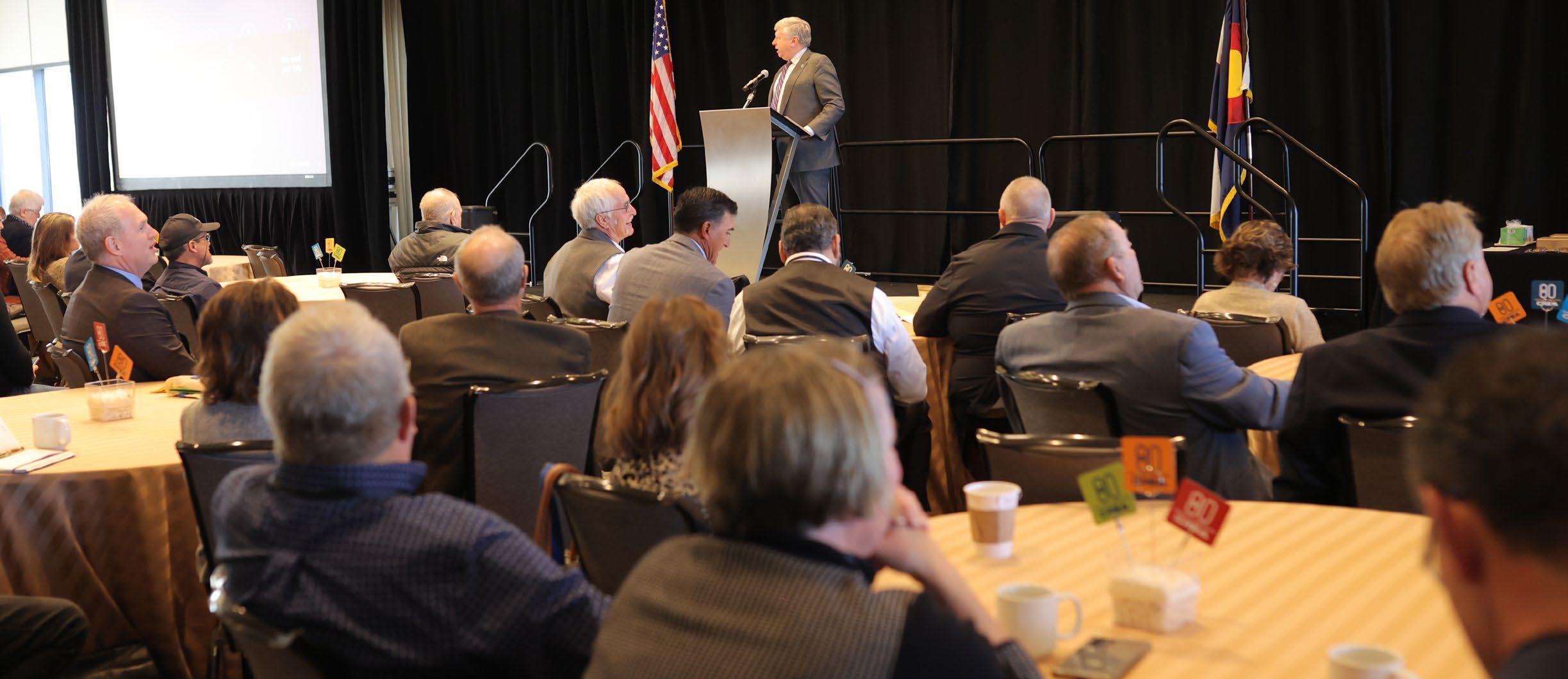
By Kent Singer Executive Director
Eighty years! That’s how long the Colorado Rural Electric Association has been advocating for and providing services to Colorado’s electric cooperatives. Founded in 1945, our trade association has partnered with our member co-ops for decades to support their mission of providing reliable and affordable electricity to all corners of Colorado. We celebrated our 80th anniversary during the recent annual meeting of our members in Denver; here are some highlights.
In addition to full-day education sessions focused on cooperative governance and power supply issues, we hosted an amazing group of speakers on a wide variety of topics: an economic update from CFC; an update on activities in the U.S. Congress from CoBank; a state political update from our CREA government relations team; a panel discussing data centers and their potential impacts on co-ops, and a co-op power supplier conversation.
The meeting was an opportunity for co-op directors and CEOs to hear the latest on what’s happening in the fast-moving electric industry.
Attendees also heard from Walter Haas, the head of the Navajo Tribal Utility Authority. We have worked with NTUA for the last couple of years to send co-op lineworkers to the Navajo Nation in northern Arizona to help build electric lines to homes without access to power. Last year, line crews from seven Colorado electric co-ops worked with employees of NTUA to construct distribution lines to serve dozens
of families. Haas made a special trip to Denver to thank our co-ops and CREA for their contribution to this work. We look forward to continuing our support of NTUA to help power the lives of the many Navajo citizens who are still living without electricity.

Our annual meeting is always scheduled when the Colorado General Assembly is in session so that we can meet with legislators and talk about issues that concern electric co-ops. We had great participation by the members of our legislature again this year and we had a chance to talk about the many issues facing our members, including the risks posed by wildfires on rural communities.
Our 80th annual meeting was a huge success due to the engagement of our members and the excellent work of the entire CREA team. We look forward to another 80 years protecting the interests of Colorado’s electric cooperatives!
Kent Singer is the executive director of CREA and offers a statewide perspective on issues affecting electric cooperatives. CREA is the trade association for 21 Colorado electric distribution co-ops and one power supply co-op.


An initiative of the Navajo Tribal Utility Authority in coordination with the American Public Power Association, Light Up Navajo brings electricity to families living on Navajo Nation.
Crews from utilities across the United States travel to Navajo Nation to set power poles, run power lines, and prepare homes to receive electric service. From April 6 to July 27, eight volunteer linecrews from Colorado electric co-ops will participate in Light Up Navajo VI.
Navajo Nation spans an area larger than the entire state of West Virginia and is home to approximately 186,500 Navajo citizens. More than 10,000 families live without basic electricity at home. Bringing power to these homes will provide families with modern conveniences such as electric lighting, refrigeration for food, and access to electric heat and air conditioning.
In 2024, 170 homes were connected to the grid.
You can make a difference for those in need. Donate to the Colorado Electric Educational Institute today and support Colorado electric co-op volunteer linecrews for this important and impactful work.

To donate, scan this QR code with your smartphone camera, visit crea.coop/current-causes, or mail a check with “Light Up Navajo” in the memo line to CEEI c/o CREA 5400 Washington St., Denver, CO 80216.


Melinda, CCL’s editorial assistant, loves birds. So much, in fact, that she brought her binoculars to work to keep an eye on the hawks and herons that fly by our office windows. Though our office is in a rather industrial part of Denver, we enjoy a wall of windows that provide great views of nearby trees and a pond. Her excitement is also contagious when she turns the page in her one-page-a-day calendar filled with colorful pictures of, you guessed it — birds — and shares the bird of the day.
As we were proofreading this issue and turned to page 12, Melinda was undoubtedly excited to see the photo of the bird at the top of the page. As you’ll learn in the column, there’s a free birding app you can download to your smartphone that helps identify birds you see or hear. Of course, she’d had this app for awhile and can attest to its usefulness. Whether you are an avid birder or are just starting out, we hope Becky Jensen’s take on birding will inspire you to keep your eyes up and your ears out for our feathery friends.

STAFF
Cassi Gloe, Publisher cgloe@coloradocountrylife.org
Kylee Coleman, Editor kcoleman@coloradocountrylife.org
Melinda Taylor, Editorial Assistant mtaylor@coloradocountrylife.org
SUBSCRIBERS
Report change of address to your local cooperative. Do not send change of address to Colorado Country Life. Cost of subscription for members of participating electric cooperatives is 30 cents per month, paid from equity accruing to the member. For nonmembers, a subscription is $15 per year in state/$20 out of state.
advertising@coloradocountrylife.org 720-407-0712
National advertising representative: American MainStreet Publications 611 S. Congress St., Suite 504 Austin, TX 78704 | 800-626-1181
Advertising Standards
Publication of an advertisement in Colorado Country Life does not imply endorsement by any Colorado rural electric cooperative or the Colorado Rural Electric Association. Colorado Country Life (USPS 469-400/ISSN 1090-2503) is published monthly by Colorado Rural Electric Association, 5400 Washington St. Denver, CO 80216-1731. Periodical postage paid at Denver, Colorado. ©Copyright 2025, Colorado Rural Electric Association. Call for reprint rights. View advertising and editorial policy terms and conditions online at coloradocountrylife.coop/legal.

Denver Corporate Office 5400 Washington Street Denver, CO 80216
info@coloradocountrylife.org 303-455-4111
Editorial opinions published in Colorado Country Life magazine shall pertain to issues affecting rural electric cooperatives, rural communities, and citizens. The opinion of CREA is not necessarily that of any particular cooperative or individual.

By Dennis Herman General Manager
Last year at about this time I shared news of a rate increase coming from our wholesale power provider, Tri-State Generation and Transmission Association. Tri-State filed a rate with the Federal Energy Regulatory Commission that represented a rate increase and a cost realignment. The realignment reallocated Tri-State’s cost recovery which, unfortunately, recovers more revenue from low load factor systems such as Highline Electric Association. Review my explanation of load factor in my August 2023 article on our website at hea.coop by navigating to Colorado Country Life under the Community tab.

set aside in prior years to cover the shortfall in our 2024 margin. I shared with you at the time that a similar rate adjustment was likely in 2025 to fully implement that wholesale rate increase from Tri-State.
At its December meeting, the Highline Board of Directors approved a rate increase for 2025 that results in approximately the same increases to the same classes as the rate increase implemented in 2024. The percentage increase will vary from account to account based on the individual usage characteristics of each account. This rate increase will go into effect with the bill due on March 17.
As a result of the cost realignment from Tri-State, Highline completed a cost of service study to aid in implementing the rate change fairly across rate classes. The COS study indicated that we need to implement rates that increased fixed cost recovery and decreased our variable cost recovery. In general, this means increases in access charges and the implementation of, or increase in, demand charges. The increase in fixed charges is countered by little or no change in energy rates, with energy charges decreasing in some instances. It was also evident from the COS study that there was a variance in cost recovery across rate classes. To alleviate this variance, the majority of the 2024 rate increase was borne by increases to two rate classes: Farm and Residential increased 7.1% and Irrigation increased 4.3%
These changes resulted in an overall rate increase of 3.5% which was half of the rate increase necessary to account for the wholesale rate increase from Tri-State. Highline utilized deferred revenue that was

For irrigators who participate in our voluntary load control program, there is a bit of a silver lining to the rate change. The discount that irrigators receive for participation in the load control program increased across all five program options last year.
Tri-State has not raised their wholesale rate since 2016. Power suppliers across the Rocky Mountain West have increased their rates over the past few years, so it’s not surprising that Tri-State needs a rate adjustment. Tri-State and Highline have both been subject to the same inflationary pressures that have been felt by all consumers over the last few years.
Highline staff works diligently to provide you, our members, with safe, affordable, and reliable energy. As a nonprofit electric cooperative, we don’t have the same profit motives that drive investor-owned utilities; rather, you, our members are our shareholders and drive everything we do. We will continue to work with Tri-State to provide you with the best value possible in your electric service.
1300 S. Interocean P.O. Box 57
Holyoke, CO 80734-0057
phone 970-854-2236
toll free 800-816-2236
info@hea.coop
Holyoke & Sterling: M-Th 7 a.m.– 5:30 p.m.
Ovid: Mon., Tues., Thurs. 9 a.m.–3 p.m.
hea.coop facebook.com/HighlineElectric

At Highline Electric Association, we believe every child should have the opportunity to succeed and can think of no better start than ensuring the children in our communities grow up in homes filled with books that inspire a passion for reading and lifelong learning. In 2024, we partnered with Midwest Electric Cooperative to provide startup funding and support for a new Imagination Library chapter in Perkins County, a program championed by the Hastings Memorial Library.
This marks the fourth Imagination Library chapter within HEA's service territory that the co-op has proudly supported with startup funds and coordination assistance. Through this partnership, we’re helping make free, high-quality books available monthly to children from birth to age five, fostering early literacy skills and a love of reading during their most formative years.
“The Imagination Library is a powerful program that transforms lives by opening the door to literacy and learning,” HEA General Manager Dennis Herman said. “We’re thrilled to work alongside Midwest Electric Cooperative and Hastings Memorial Library to bring this opportunity to families in Perkins County.”
Though this achievement was realized last year, we are excited to share the news with our members now as the program continues to grow and reach more families. HEA’s support in this initiative is a testament to the co-op’s commitment to the communities it serves
We encourage families with young children in Perkins County to enroll in the program and take full advantage of this wonderful resource. For more information about the Imagination Library, please contact Hastings Memorial Library at 308-352-4894 or visit hea.coop/dolly-partons-imagination-library.

Did you switch cellphone providers and get a new phone number? Or did you decided to disconnect your landline? Maybe your mail isn’t delivered to your house anymore and you pick it up at the Post Office.
Whatever it may be, make sure we have your most up-todate phone numbers, mailing addresses and anything else that can help us reach you if we need to contact you.

It’s called a controlled burn for a reason. If you don’t plan your controlled burn in advance and keep it under check, it can quickly spread too far and wide.
Even with the best laid plans, a utility pole could catch fire during a burn. However, planning in advance can decrease the chances. Fire damage to a power pole is usually evident by blackening and scorch marks, but even slight discoloration can cause serious problems. Sometimes the poles burn from the inside out and the damage is not immediately apparent.
To inquire about controlled burns near power poles and lines, contact Highline Electric Association at 970-854-2236.
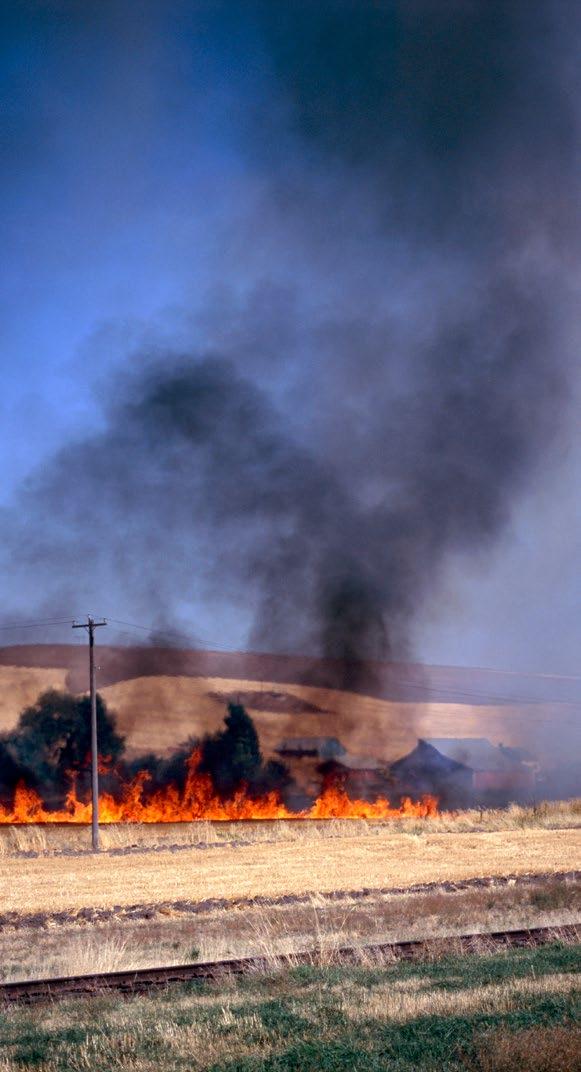

Operations Manager Rance Ferguson retired February 10 after 32 years working at Highline Electric Association. The former Holyoke line superintendent moved into his role as Operations Manager in 2015.
On March 25, Highline’s offices will close early due the Annual Meeting. The Sterling office will close at 3:30 p.m. The Holyoke office will close at 4 p.m.
Highline Electric Association’s 2025 Annual Meeting is fast approaching. This will be Highline Electric’s 87th anniversary.
Join us March 25 in the Phillips County Event Center at the fairgrounds in Holyoke. Members will receive a direct mailing notice this month with the most up-to-date information regarding the meeting. This meeting will also be livestreamed and details will be posted online at hea.coop
Board President Mike Bennett and General Manager Dennis Herman will give reports on the condition of the association.
Also at the meeting, an election will be held for four director positions. These positions require the nominees to be members of HEA and comply with Article III, Section 3 of the association’s bylaws.
There will be one director position from District 1, and the nominees must reside in Logan, Weld, Washington, or Morgan County, Colorado. The incumbent director for this district is Leo Brekel.
There will be one director position from District 2, and the nominee must reside in Phillips or Yuma County, Colorado. The incumbent director for this district is Steve Oestman.
There will be one director position from District 3, and the nominee must reside in Sedgwick County, Colorado, or Deuel County, Nebraska. The incumbent director for this district is Ted Carter.
There will be one director position from District 4, and the nominee must reside in Chase, Perkins, or Dundy County, Nebraska. The incumbent director for this district is Lisa Schilke.
Sign up for Highline Electric Association’s bill pay programs and you can earn up to $12 per year.
Auto Pay. Securely link a credit card or checking account to your Highline account and your balance will paid each month automatically on the due date. Save time, avoid late fees, and earn a $.50/month bill credit.
Paperless Billing. Are papers cluttering your kitchen counter? Sign up to get your Highline statement emailed to you every month and we’ll give you a $.50/month bill credit.
Call or visit your local Highline office to set up auto pay and paperless billing and have more time for what matters.

The deadline to retire an irrigation service is April 15. After this date, you will be charged the annual minimum.
Congratulations to the following HEA employees who observe an employment anniversary in March:
Deon Skomp - 32 years
Robie Adams - 21 years
Ryan Bingham - 9 years
Tracy Simpson - 9 years
Diana Baeza - 2 years

By Vicki Spencer
For years my daily walks would take me past a neighbor’s home where I admired their backyard greenhouse. In winter, I was drawn to brilliantly colored flowers protected from the snow glistening outside. I often dreamed of the day when I could afford to build my own glass greenhouse.
Flash forward a few decades. Now there are many affordable greenhouse options, including build-ityourself kits. However, before you invest time and money in the ultimate fantasy, consider experimenting with hoop tunnels and cold frames. You will learn skills, techniques, and more importantly, the effort required for offseason gardening.
Begin by determining what you want to achieve. If you live in the high country, do you want to extend the growing season for tomatoes to ripen on the vine? If you live on the Western Slope, do you want to help late-season crops survive hot, dry summers? If you live along the Front Range, do you want to prevent deer and rabbits from enjoying your produce before it’s ready for you to harvest? Answering questions like these will help you decide the best structure for your individual needs.
Regardless of your choice, be strategic about where you place the structure. Since sunshine is essential for growing healthy plants, orient your structure to run from east to west. This will allow more sunlight to penetrate when the winter sun is low. But too much of a good thing can be fatal in summer when sunlight is more intense. You can use shade cloth just like it’s used in traditional gardens to protect cool-season greens, prevent sun scald and early bolting, and retain moisture.
People often focus on how closed structures keep the cold out, but often forget how hot they get in the summer. Cold frames can be ventilated by propping panels open for a while, but larger structures typically require fans for circulation. Even if you begin with a cold frame, consider a potential source of electricity in case you decide to upgrade later. A variety of electrical systems are available for greenhouses, but automatically controlled systems are designed to provide a consistent supply of carbon dioxide, which may result in greener leaves, stronger stems, and earlier flower blossoms.
All closed structures prevent moisture from entering, so plant health is entirely dependent upon regular watering. Obviously, the more accessible the water source, the easier your task. Adding automatic timers to hoses and drip systems will make it much more convenient.
As with any garden, you’ll want to plant seeds in soil with the proper pH. But gardening in a controlled environment means you must regulate sunlight, temperature, and moisture — this takes more effort than relying solely upon Mother Nature. Nonetheless, the benefit of fresh vegetables and pretty flowers during the winter is worth it.
The internet provides a plethora of information about greenhouses. My favorite resource for building my greenhouse was Growing Under Cover by Niki Jabbour, Storey Publishing, 2020.
Master gardener Vicki Spencer has an eclectic background in conservation, water, natural resources, and more.
By Becky Jensen

Abird call pierces the crisp morning air near my cabin in the Poudre Canyon. “Ping! P ing! Ping!”
Living on my own, I enjoy getting to know my wildlife neighbors, large and small. They are fascinating company. The high-pitched note rings out repeatedly, like an invitation, as I walk my dog down our dirt lane. I’ve heard this sound before, but the bird and I have never officially met. Today, I’m determined to learn its name.
After returning my dog to the house and his warm bed by the fire, I grab my phone and binoculars.
Back outside, I slowly walk over to where I think the mystery bird is perched — a tall, scraggy juniper loaded with berries. The loud note penetrates the air again. I open an app on my phone, press record, and point it toward the tree.
As a beginning birder, I struggle to visually tell some birds apart, as well as match melodic songs or sharp calls to their owners. Black-capped chickadees alone have at least 16 distinct vocalizations. I’m also terrible with names. I need all the help I can get. One of my sons, a more experienced birder, recommended Merlin Bird ID. To say I’m technology resistant is a massive understatement. But this free app has been a game changer, introducing me to hundreds of new feathered friends that would have otherwise remained strangers to me.
On my phone, a picture of Townsend’s solitaire pops up as a suggested match. I select the bird’s image and play a sample song. Not my bird, I think at first, then realize my rookie mistake. I play a sample of the Townsend’s solitaire call, vastly different from its song. Bingo! It sounds exactly like my hidden visitor. Merlin’s brief description helps me get to know it a little better. “Sleek songbird, a bit smaller than robin and much slimmer. Overall plain medium-gray with short bill, rather long tail, white eye-ring ...”
Armed with this info, I now know what to look for. I scan the tree’s upper branches, spot a single gray bird, and zoom in with my binoculars. To my delight, its white eye-ring comes into clear focus. “Loves juniper,” Merlin further divulges, another satisfying clue. It’s a Townsend’s solitaire, all right. I click “This is My Bird,” and Merlin magically adds it to my growing list.
I look up at my new acquaintance, and witness the moment it opens its beak. “Ping!” it calls out. “Ping!”
I wave in acknowledgment, one solitaire to another.
“Nice to meet you, neighbor.”
Becky Jensen is a writer and podcast contributor who lives and works in a little cabin on a big river in Northern Colorado. She’s a former farm girl turned mountain mama, and a proud member of Poudre Valley REA. You can find her at beckyjensenwrites.com
For only $29, get a Keep Colorado Wild Pass with your next vehicle registration and share your love of Colorado’s outdoors. The pass gives you entry to all state parks and helps fund more outdoor education opportunities in local communities.
cpw.info/KeepColoradoWildPass


By Jim Hight
Like every electric utility in Colorado, your local electric cooperative is managing a lot of change right now. State policies are phasing out the old workhorse of electrical generation — coal-fired power plants — and rapidly expanding wind and solar power, which have many benefits but only produce electricity when the wind blows or the sun shines. And what used to be a one-way flow of electrons from power plants to consumers is increasingly a two-way street as residential solar grows dramatically.
Fortunately, co-ops are innovating with new technologies that manage the changing electricity system: hardware and software to visualize and control what’s happening on their grids, smart inverters that adapt solar output to local grid conditions, and — the biggest game changer — batteries and other devices to store energy.
Holy Cross Energy, for example, pairs solar power with battery storage to “throttle up and
down the output from our solar-plus-storage resources just as a utility would turn up or down the output of a conventional power plant,” said Bryan Hannegan, president and CEO of the Glenwood Springs-based electric cooperative.
In addition to making solar output more reliable, energy storage enables co-ops to reduce electricity consumption during periods of high demand. “Our distributed storage capacity allows us to move a large part of the electric heating load on our system to the inexpensive off-peak period,” said Jack Snell, energy services manager for San Isabel Electric Association, an electric co-op based in Pueblo West.
These features won’t sound very important until one understands how they allow electric co-ops to reduce costs and potentially avoid raising rates.
Because of physical laws, electricity generation must always match consumption. If supply runs short of demand, grid operators might have
to take radical measures such as disconnecting sections of the grid to avoid damaging system infrastructure and electric appliances.
Therefore, Colorado’s electric grid is built to supply the maximum electricity demand that could occur at any time — such as on a frigid winter morning. A share of the cost of building and operating the power plants, high-voltage power lines, substations, transformers, poles, and wires needed to meet that maximum — or peak — demand is passed on to your co-op. This demand charge is the co-op’s share of the total system capacity that wholesale power suppliers have to build and maintain to serve the combined set of peak demands on their system, explained Hannegan.
Wholesale power suppliers base demand charges on how much electricity a utility uses during the one hour each month when regional electric demand peaks. With energy storage, utilities can stock up on or store electricity when demand is low and there’s excess capacity, then dispatch that stored electricity to offset their usage during peak periods when demand charges are set.
Colorado’s electric co-ops have installed hundreds of megawatt-hours of battery electric storage systems — and they have hundreds more MWh in development. Some co-ops are investing in their own large batteries that are usually paired with solar, tapping into smaller batteries owned by their consumer-members — again, typically paired with solar — or both.
Holy Cross Energy is bringing online 55 MWh of co-op owned battery storage paired with solar power plants while contracting with growing numbers of consumer-members who install solar and battery systems and agree to let the co-op charge and discharge their batteries at necessary times. “These members help us by contributing power when needed, consuming power when there’s excess solar or wind power, and shifting demand from one part of the day


when electricity is expensive to another part of the day when it’s not,” Hannegan explained.
It’s important to mention that utilities can store electricity without batteries. San Isabel Electric Association uses heat stored in ceramic brick structures built into home heaters. About 1,500 SIEA consumer-members have installed electric thermal storage heaters from Steffes, and, collectively, they shift about 10 MW of electric load away from peak demand periods when that costly demand charge is calculated.
The key to making this work is a time-of-use billing system that gives electric thermal storage heater users a sharply discounted rate for heating up those bricks during off-peak periods. SIEA sells the ETS units, installs, and services them; the co-op even provides a lifetime warranty for a one-time fee. “This inspires confidence,” said Snell. “They know that the co-op is never going to exit this market, that we’ll always be here for them.”

One megawatt, or 1,000 kilowatts, is a unit of instantaneous power levels, while a megawatt-hour is 1 MW sustained for one hour. One MWh is about enough to power 100 to 200 all-electric homes for one hour on a cold winter morning. Battery capacities are usually expressed in kilowatt-hours or MWh, while the peak demands discussed in this article are measured in MW.
By Mary Peck
What makes the sky blue? How does a fish drink water? Why does that person look different from me?
Anyone on the receiving end of a seemingly endless barrage of a preschooler’s questions knows the feeling: exasperation mixed with a shared curiosity about answers to those questions.
Harnessing this abundance of curiosity is essential to early childhood education. Between ages 4 and 5, children are ideally suited for questioning and learning. Their brains are still developing, and they’re not yet applying labels or assumptions, noted Warren

I think, at a child’s birth, if a mother could ask a fairy godmother to endow it with the most useful gift, that gift would be curiosity.
—Eleanor Roosevelt
Berger, author of A More Beautiful Question.
Early childhood educators view curiosity as crucial to a child’s development — not only academically, but emotionally and socially as well. The school classroom is an ideal environment to engage with young students’ curiosity about the similarities and differences among their peers.
“When young kids come to school, they’re part of a new community and growing into the human beings they’re going to be, so what better time to make our school community the best it can be? Acceptance, inclusion, and kindness are so important,” says Kate
Silverman, educational consultant and former teacher and school administrator.
No one is more aware of the need for curiosity around acceptance, inclusion, and kindness than parents who know firsthand the value of their young child being accepted.
“People with disabilities are often marginalized, and others don’t see them as whole people,” says Rebecca Macsovits, Colorado-based author.
Macsovits’ oldest son, Guion, who thrives with Down syndrome, has been an inspiration for her work and advocacy for acceptance and empathy since he came into the world 18 years ago.
“It was about a year after he was born, I had the idea for a rainbow-maned lion with a message of seeing people who look different on the surface — but you really have to be curious to see what’s underneath,” Macsovits says.
Her idea became reality when her children’s book, Guion the Lion, was published in 2020. The colorful
book is filled with messages of compassion and curiosity for young children, helping them see the fun to be had in appreciating everyone’s differences.
“The book is inspired by someone with a disability, but the focus is on impacting everyone and making them a better human being,” Silverman says.
It didn’t take long for the value of Guion the Lion’s universal message to be realized on a larger scale. Driven by the inspiration of the book and her own desire for a world where every child is accepted and included, Macsovits launched the Curious B.E.I.N.G.s educational platform in 2023.
“The theme is curiosity, and the problem to solve is judgment,” Macsovits says. “You immediately have judgments when you meet a person, and the way to fight judgment is curiosity. It’s at the heart of what we do.”
She adds, “We’re all guilty of it — it doesn’t have to

Objective: Students will be able to use their imaginations to change an ordinary object into something new.
Take Away Concepts
● It’s good for people to see and do things differently.
● Asking questions and being curious helps us see other people’s perspectives.
Vocabulary
● Different (Not the same)
● Curious (Excited to learn and ask questions)
● Imagination (Your own magical playground inside your head where anything is possible!)
● Perspective (Seeing something in a new way)
Materials
● Guion The Lion Book
● Brightly colored crayons, markers, or colored pencils
● Scissors
● Copies of Guion The Lion Mask Template
● Optional: Glue stick and popsicle stick or string
Lesson
1. Warm Up/Introduction (Activate background knowledge)
● Frontload vocabulary words as outlined above.
● Introduce Guion The Lion
● Review Take Away Concepts.
2. Discussion Questions
● Read “Guion The Lion” and pause throughout to engage students in higher following are suggestions for discussion or think-pair-shares:



■ What are some of the fun and exciting things Guion sees throughout the book?
■ Guion sees the world from a creative point of view. Think of a place in your everyday world. What do you think Guion might see?

and her oldest
for her work and advocacy.
be a child, even adults do this. Part of the reason we delved into this space is to get to kids when they’re young to help them stay curious and open minded.”
Curious B.E.I.N.G.s is designed as a supplement to educational curricula to support young people’s social development and help shift an outdated narrative of ‘disability’ to ‘hidden ability.’ Silverman, who is helping develop the platform, said the curriculum is turning the social construct around disability on its head and addressing a big gap in the classroom.
“Historically the conversation around disability has been focused on what students can’t do,” Silverman says. “We are shifting the narrative to celebrate what students can do — their strengths, their hidden abilities, and all the things that make them special and unique.”

As the Curious B.E.I.N.G.s platform continues to grow, Macsovits is amazed by Guion’s positive impact and influence among his family, friends, and beyond.

The word “B.E.I.N.G.” is formed by the program’s core values: to be kind, encourage compassion, inspire creativity, nurture courage, and grow your mind. Macsovits says these values are needed to be a successful person in society.
The curriculum includes lesson plans with fun, engaging activities that complement the message of Guion the Lion. A teacher resource kit with tools to help lead conversations in a kid-friendly way that doesn’t shy around answers about disabilities is also included.
“Of course there are going to be questions about disabilities specifically,” Silverman says. “Kids are going to have questions, and we don’t always have the support for the conversations. This really gives the support teachers need to normalize disability.”
The young program is still in its pilot phase, with about 1,000 students having participated in six schools across Colorado and in Illinois, New York, Ohio, Tennessee, and Maryland. Guion’s own kindergarten and elementary school teacher, Simón Price, has piloted the lessons and said the messaging about curiosity has been very well received by her students.
“It led to some nice, authentic conversations in the classroom about acceptance and differences — accepting and celebrating that,” Price says. “It’s a global message, respecting different perspectives and ways of thinking, and seeing the person first.”
Silverman reiterates that educator feedback has been positive and constructive. As the program’s creators continue to work with educational experts to hone its content, they are also building an online resource portal for teachers and parents. The longterm goal is for Curious B.E.I.N.G.s to become a national program in classrooms and libraries, filling a gap in social education for young learners and complementing school districts’ full student-centered learning curricula.
“All of this came from someone who has Down syndrome. We believe these life skills are universal, and we need to make sure we hold on to our inspiration.”
Guion’s many hidden abilities, Macsovits says, include his sharp sense of humor and incredible emotional intelligence — the ability to sense how someone is feeling, quickly offering comfort when it’s needed, and bringing joy and connection wherever he goes.
Guion — a fitness enthusiast — is set to graduate from high school this spring and is exploring what his postsecondary educational path will be. His mom says that his school experience has been good for not only him but good for his classmates too.
“The beauty of having someone with a disability in the classroom, and why inclusive classrooms are important, is because the learning can actually be richer,” she says. “For the typical person, they are growing too — learning empathy, leadership, life skills they wouldn’t necessarily have gotten if they weren’t in that classroom. It’s a win-win.”
Even though Guion’s school years are ending, Macsovits’ work is expanding. She is writing a second book and has a vision for a full book series focused on courage and the idea of “being comfortable with being uncomfortable.” She also regularly writes articles for the Curious B.E.I.N.G.s website on a broad range of topics, including championing inclusion and gift ideas that support social-emotional learning.
Updates on the Curious B.E.I.N.G.s platform, as well as Macsovits’ collection of articles, the Guion the Lion book, and many other resources for embracing empathy and celebrating diversity, can be found at curiousbeings.org
Mary Peck is a writer and substitute teacher in Northern Colorado. She enjoys telling stories of fellow Coloradans and is continually amazed by the many hidden strengths and abilities of the students she meets in the classroom.

by Rebecca Macsovits

BE HONEST
It is very important to talk about the differences between your kids and kids with disabilities as honestly as possible. Acknowledge differences while emphasizing that different doesn’t mean bad.
USE POSITIVE EXPLANATIONS
Don’t forget that you are your child’s biggest role model! If you are using positive language about those with disabilities, your child will, too. A great example is to explain that a wheelchair helps their classmate move around.
EXPLAIN HOW DIFFERENCES MAKE THIS WORLD A MORE BEAUTIFUL PLACE
Our similarities may bring us together, but we grow through differences. When we embrace these
differences, we deepen our understanding and appreciation of others.
TEACH YOUR CHILD ABOUT KINDNESS AND INCLUSION
In raising Guion, I have experienced firsthand how individuals flourish through connection with others and how it all starts with kindness. Teach your child to choose to be kind to and inclusive of everyone they meet.
READ CHILDREN’S BOOKS ABOUT DIVERSITY
Adding stories to your children’s book collection that include characters with disabilities can be an easy way to introduce the topic in your household or classroom.
WORLD DOWN SYNDROME DAY – MARCH 21
World Down Syndrome Day has been observed by the United Nations since 2012 with a goal of helping others understand and better support people who have Down syndrome.
This year’s theme is Improve Our Support Systems. It’s a call to governments worldwide to support the rights of people with Down syndrome to be included in education, receive quality health care, hold a job, participate in sports, and many more rights. Visit worlddownsyndromeday.org to get involved and learn more.

By Michael Baldauf

Q: What is grounding, and why is it important?
A: Many people believe if an electrical device is working, then it must be hooked to a properly wired outlet. Be aware that some electronics will operate even if connected improperly, but this can severely injure the user. To ensure your hair dryer, clothes dryer, stove, and other appliances will function properly and safely, make sure your home and outlets have proper grounding.
“Ground” literally means the earth or ground in the term “path to ground” because electrical circuits can be connected to the ground. A ground wire is a wire that has been intentionally connected to the earth but does not typically carry electricity, although it can if the system detects a problem.
When buildings are erected and the electrical system is installed, grounding is essential and inspected along with everything else. The requirements for grounding are specified by the National Electrical Code and may be modified to suit the local building codes. Typical home codes include an 8- or 10-foot ground rod pounded into the earth near the electrical entry to the building. The end of the rod is welded to a copper wire to the ground screw in the electrical panel.
Grounding systems are important because they provide:
• Protection from electrical shock. The grounding wiring increases the possibility that malfunc-
tioning equipment will trip a circuit breaker rather than be a shock hazard.
• Protection from atmospheric static discharge, including lightning. If your home has proper grounding, lightning is more likely to dissipate the energy pulse through the grounding wires rather than finding its path through the electrical system and destroying devices and appliances.
Ground-fault and arc-fault circuit interrupter outlets detect whether electricity is staying inside the circuit or leaking out somewhere else (like through you). This protection is especially good for damp areas of your home such as the kitchen and bathroom and is required for many new or remodeling wiring projects. GFCI circuits are available to install in both wall outlets and circuit breakers. Test your GFCI outlets monthly.
Proper grounding is an easy way to reduce the possibility of shock and fires. As more of the devices we use can be damaged or destroyed by unstable power, grounding is more important than ever. If you need more information about your home’s grounding system, hire a qualified electrician to inspect it.
Michael Baldauf is an electrical instructor and broadcast engineer and lives in Rye.

























✓ Commercial Grade Non-Slip Floor
✓ Easy-to-reach Shower Wand
✓ Professionally Installed in 1 day
✓ Fold Down Safety Seat
✓ Luxurious 8" Rainfall Shower Head
✓ Ergo L Shaped Grab Bar
✓ Lifetime Warranty
✓ Optional Barrier Free Wheelchair Accessible










DO MORE WITH A HEAT PUMP
Comfortably heat and cool your home more efficiently while saving money. When paired with proper insulation, you can save over 30 percent on your heating and cooling bills compared to conventional HVAC systems, according to the U.S. Department of Energy. Both ducted and ductless heat pumps provide efficient HVAC solutions that will improve your home’s air quality while eliminating the need for combustible fuels.
DUCTED AND DUCTLESS SYSTEMS


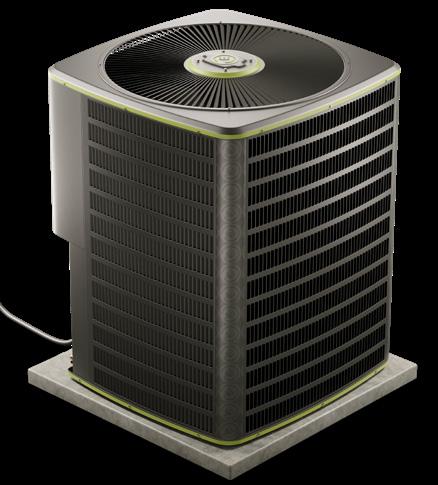


Together with our members, we’re extending the benefits of electrification for schools, homeowners, businesses, agricultural producers, nonprofits and more. LEARN MORE AT WWW.TRISTATE.COOP/ELECTRIFY-AND-SAVE
Recipe Courtesy of Sisters on the Fly

We are only days away from welcoming spring. But any Coloradan knows that March can be as tricky as a leprechaun and can sneak in a few snowstorms — even after the vernal equinox. Keep warm this month with this recipe for an award-winning chili.
1 lb ground turkey
1 lb ground beef
1 medium onion, chopped
2 14-oz cans beans of your choice
2 14-oz cans diced or crushed tomatoes
1 8-oz can tomato sauce
3-4 tbsp chili powder
1 tsp ground cumin
1 tsp salt
1 tsp pepper
½ c chopped green peppers
1 8-oz can diced mild chiles (optional)
Grated sharp cheddar cheese
Sour cream
Green onions, finely chopped
Brown meat. Add onions halfway through, cook until soft, then drain. Add remaining ingredients and cook for 20 minutes. Season with salt and pepper to taste. Garnish with grated sharp cheese, finely chopped green onion, and sour cream.

















By Denise Moore Empire Electric Association
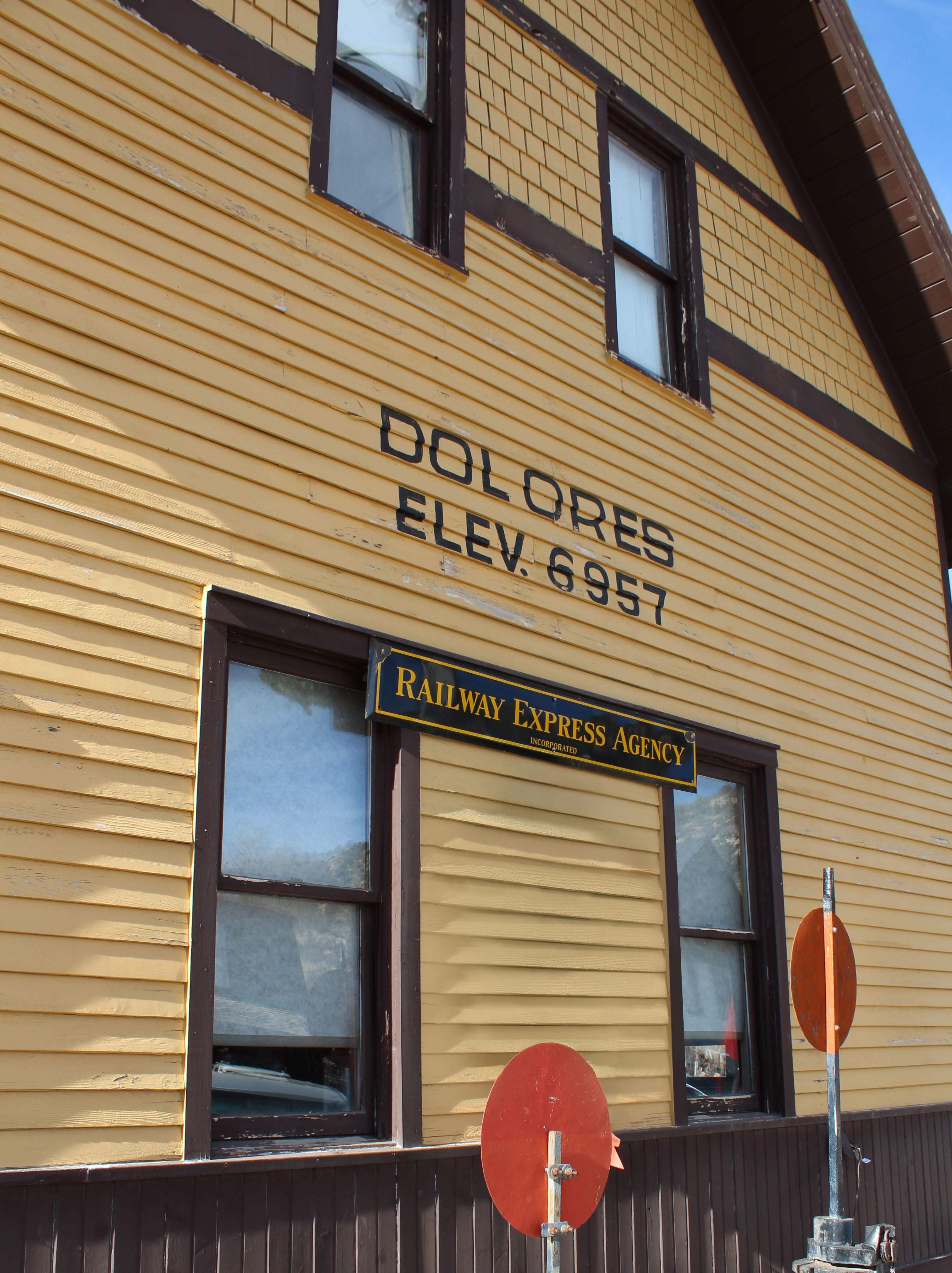
Galloping Goose Historical Society Museum features the restored and operational Galloping Goose No. 5. The museum showcases the history of the Rio Grande Southern Railroad. gallopinggoose5.org
Kelly’s Kitchen is a charming café located in a historic building at 4th Street and Central Avenue. It features several flavorful menus for breakfast, brunch, lunch, and dinner. The drink menu includes coffee, cocktails, and selections for kids. kellyskitchendolores.com

Dolores, Colorado, is a small town in a canyon bordered by rock cliffs and the Dolores River that feeds directly into McPhee Reservoir. The river was named by Spanish priests in 1776 during their journey to California, calling it Rio de Nuestra Senora de las Dolores — the River of Our Lady of Sorrows. The area was originally inhabited by ancestral Puebloans until around A.D. 1300; artifacts and remnants of their villages can still be found today. Plan a getaway to electric co-op country and enjoy all that Dolores has to offer.




The area boasts numerous hiking The McPhee Overlook Trail offers stunning views of McPhee Reservoir, the second largest reservoir in Colorado. recreation.gov/camping/ campgrounds/232146

For the adventurous, check out Dolores Bike Hostel, the “best rest in the Southwest.” This chic, modern, shared space even boasts a sauna so you can recharge your tired legs after a long day of hiking or biking. Hosts know the best trails, community events, and things to do in the surrounding area. doloresbikehostel.com










A cooperative is a business or organization owned and run by the people who use its services, so decisions are made with their best interests in mind. It’s all about teamwork and community — member-owners pool resources, share benefits, and have a say in how things operate.
Co-ops are everywhere, from rural towns to big cities. Three million co-ops support communities globally; and across the United States, more than 65,000 co-ops thrive. In Colorado, there are 22 electric co-ops serving members — you! — who can proudly say they are owners of the utility.
The United Nations declared 2025 the International Year of Cooperatives.
Why take a year to celebrate coops? The co-op model prioritizes people over profit and community over competition. When we work cooperatively, we invest in a better future for everyone.



Visit us online at coloradocountrylife. coop. Our new website features easy navigation, searchable archives, ways to contact us, and contests.
more of your Colorado Country Life magazine with our bimonthly e-newsletter. You’ll get access to exclusive content and contests!


Ebony and Rain, grandchildren of Steve and Debbie Cantril, take a break from a Disney cruise and enjoy the magazine in Cozumel, Mexico. Steve and Debbie belong to Sangre de Cristo Electric Association.

Richard Aguirre and Alexandra Hembree travel to Nashville, Tennessee, with their copy of the magazine. Richard and Alexandra are members of Sangre de Cristo Electric Association.

Virginia Pena travels to Miami, Florida, to visit her parents. Here she is at the marina enjoying CCL and the gentle breeze of a sunset evening in 73-degree weather. Virginia is a Mountain View Electric Association member.

CREA Board President Steve Valdez and his wife Sandra bring their copy of the magazine to Secrets Resort in Jamaica for a sunny getaway in January. They live in southern Colorado and are members of San Luis Valley REC.

Mountain View Electric Association members Tom and Jeannie Berens take CCL on an 11-day Antarctic expedition. Tom says, “The pristine air, the vast expanse of untouched land was a life changing experience.” DON’T FORGET TO PACK CCL FOR YOUR NEXT TRIP! Show us where you read CCL for a chance to win $25! Take a photo of someone (or a selfie!) anywhere you enjoy the magazine and share it with us under the Travel section on our website at coloradocountrylife.coop Each month we’ll draw one photo to win $25. See all the submitted photos on our Facebook page @COCountryLife.


By Gaylene Garcia Granger

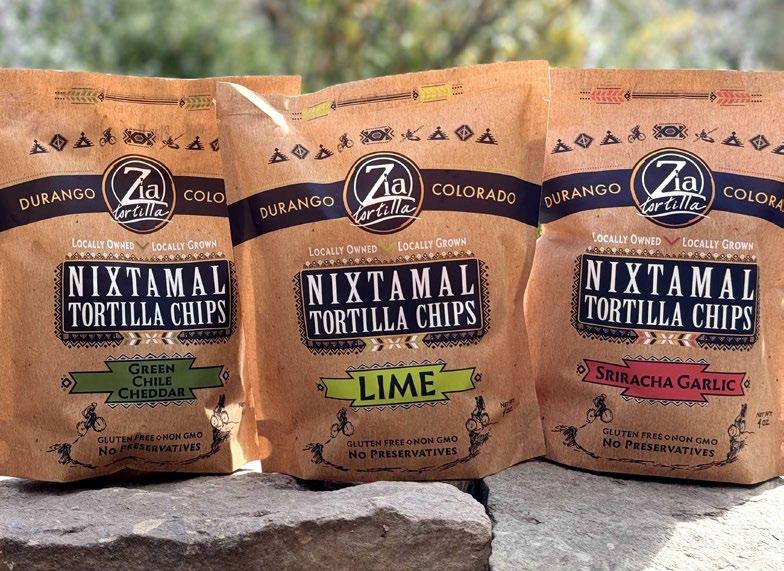
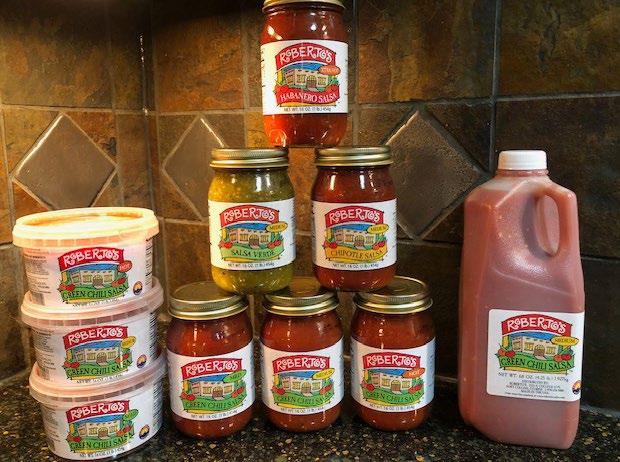
Regardless of diet or lifestyle, snacks are a fun part of everyday life. They’re tasty little sweet, salty, or savory treats that help break up the day, elevate a mood, and give you a little boost of energy. We set out to find some of the yummiest Coloradomade snacks you’ll want to get your hands on.
Gunnison Jerky Co. began online with hand-cut, top round, 100% USDA Colorado beef. This snack is smoked using hickory and applewood and comes in eight flavors including Palisade peach, maple bourbon, and Moab heat. You can buy it in person at the shop on North Main Street in Gunnison and find an ever-growing assortment of fun and healthy on-the-go snacks including Colorado honey caramels, chocolates, and flavored seeds and nuts. The shop has everything you need to keep you going for a long mountain hike or just tooling around town. Find all Gunnison Jerky Co. has to offer online at gunnisonjerkyco.com.
Zia Taqueria Cantina has been a local favorite in Durango since 2005. But in 2019, not long after opening their tortilla factory, Zia’s began a table-topantry snack that really spiced up the business. Their Zia Tortilla Nixtamal Tortilla Chips use all regional ingredients, including non-GMO Ute Mountain corn, Colorado sunflower oil, and Redmond sea salt. They still serve the chips at both of Zia’s restaurants, but if you’re not in the Durango area, you can find them at Natural Grocers and specialty markets throughout the state or order by the case online at ziatortillaco.com/store
Almost every pantry has at least one jar of salsa on the ready. Roberto’s Salsa has been a hit since the Watterson family served it tableside back in the late ’80s at their restaurant across from the Colorado State University campus in Fort Collins. It’s an old family recipe made of fresh tomatoes, onions, cilantro, and local chiles. Today, you can get it in several different flavors, including habanero, chili verde, peach, and pineapple. You’ll find it at many local supermarkets and can also buy it online at robertos-salsa.com

Colorado’s electric cooperatives are leading our state toward a sustainable future. We will continue our commitment to maintaining reliable electricity at the lowest possible cost while also advancing innovative solutions that sustain co-op communities now and into the future.
We maintain a dependable grid to keep costs reasonable while working to decarbonize energy resources.
We support local projects that employ new technologies to meet the specific needs of individual co-ops.
We support energy solutions that strengthen communities now and into the future.
The Colorado Rural Electric Association is the statewide trade organization fostering unity among and providing service to 21 electric distribution cooperatives and one generation and transmission association in the state.
CREA represents co-ops at the state capitol and supports your local electric co-op in its safety initiatives, communications efforts, and education classes.
Learn more at crea.coop


1Subject